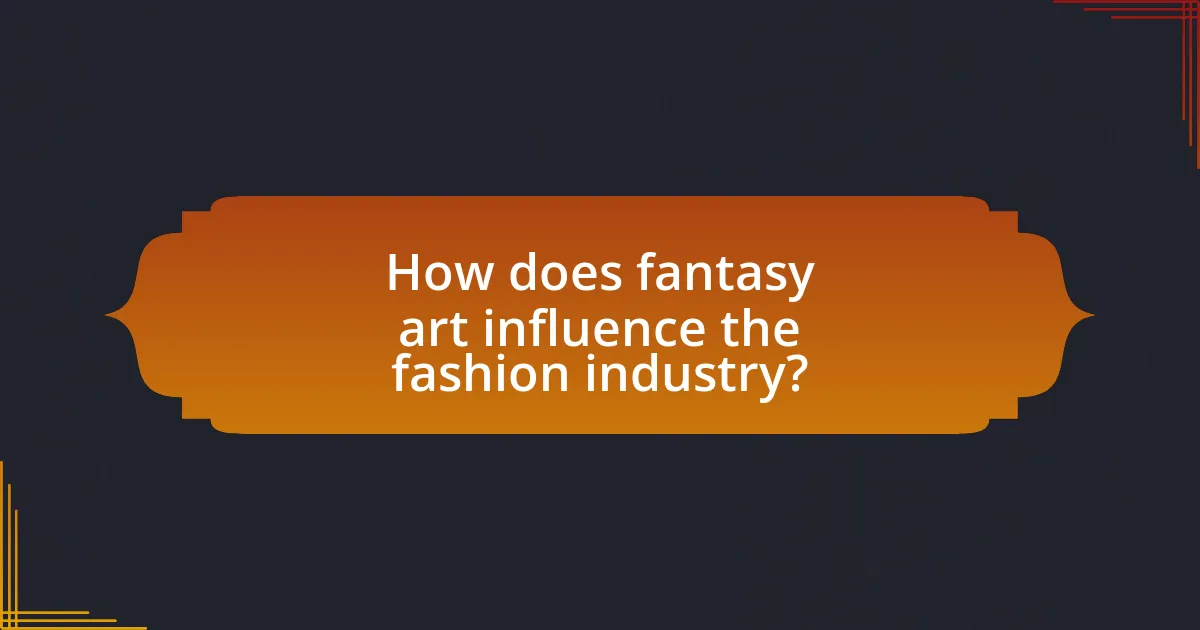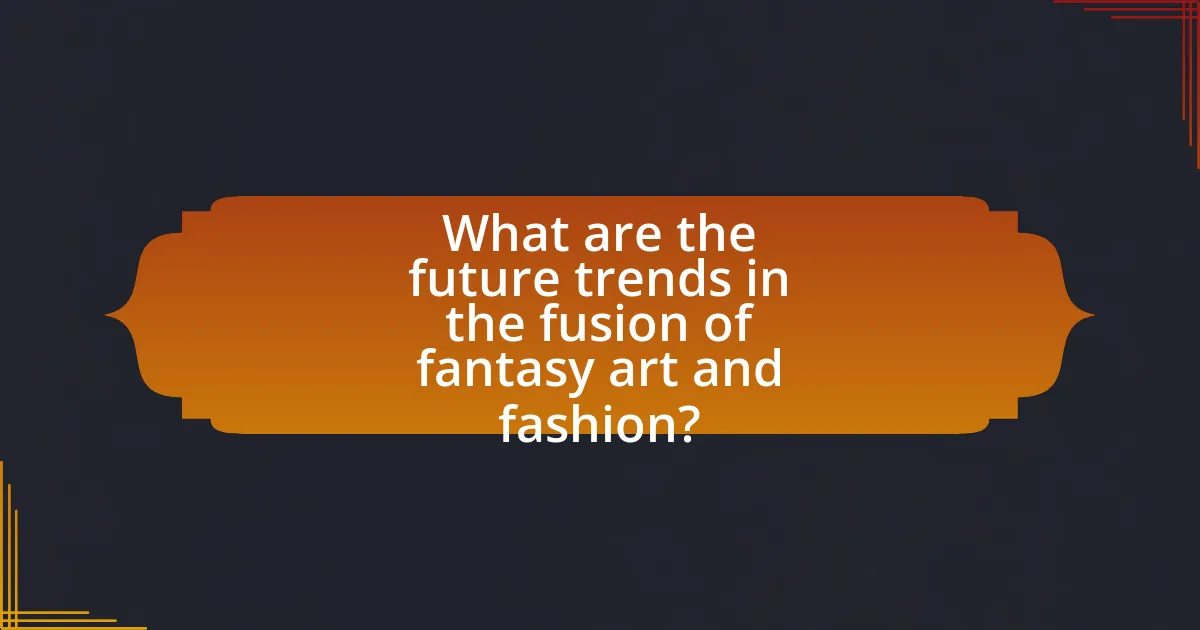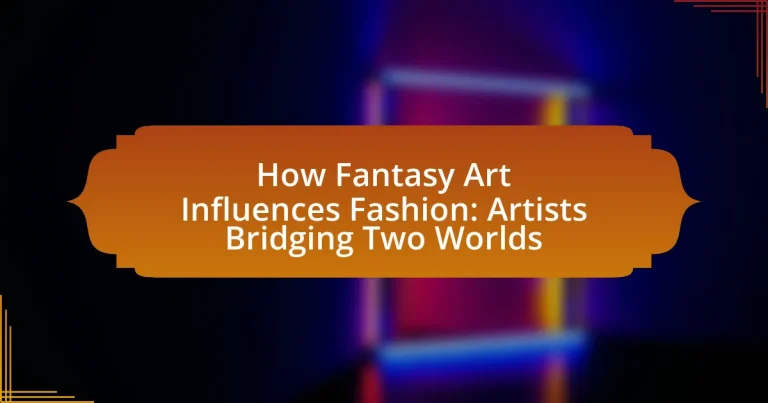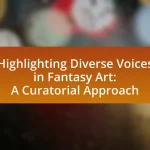The article explores the significant influence of fantasy art on the fashion industry, highlighting how designers incorporate imaginative themes, vibrant colors, and intricate motifs into their collections. It examines key elements of fantasy art that inspire fashion, such as mythical creatures and ethereal landscapes, and discusses how color palettes from fantasy illustrations shape fashion trends. Additionally, the article addresses the role of storytelling in fashion design, notable artists bridging the gap between the two fields, and the impact of technology and social media on this fusion. Future trends and practical tips for aspiring designers are also provided, emphasizing the importance of creativity and innovation in merging fantasy art with fashion design.

How does fantasy art influence the fashion industry?
Fantasy art significantly influences the fashion industry by inspiring designers to incorporate imaginative elements and themes into their collections. This influence is evident in the use of vibrant colors, intricate patterns, and fantastical motifs that reflect the aesthetics found in fantasy illustrations. For instance, designers like Alexander McQueen and Vivienne Westwood have drawn from fantasy art to create garments that evoke otherworldly imagery, merging art with wearable fashion. The popularity of fantasy-themed films and literature also drives trends, as seen in collaborations between fashion brands and franchises like “Game of Thrones,” which have led to clothing lines that capture the essence of the fantasy genre. This intersection of fantasy art and fashion not only enhances creativity but also expands the market by appealing to consumers’ desires for unique and expressive clothing.
What are the key elements of fantasy art that inspire fashion designers?
The key elements of fantasy art that inspire fashion designers include imaginative themes, vibrant colors, intricate details, and mythical motifs. Imaginative themes often draw from folklore and mythology, allowing designers to create garments that evoke a sense of wonder and escapism. Vibrant colors in fantasy art, such as jewel tones and ethereal pastels, influence color palettes in fashion collections, enhancing visual appeal. Intricate details, like elaborate patterns and textures found in fantasy illustrations, inspire designers to incorporate craftsmanship and embellishments into their clothing. Lastly, mythical motifs, including creatures and symbols, provide unique design elements that can be translated into wearable art, making fashion collections distinctive and narrative-driven.
How do color palettes in fantasy art translate to fashion trends?
Color palettes in fantasy art significantly influence fashion trends by introducing vibrant, imaginative color combinations that inspire designers. For instance, the use of rich jewel tones and ethereal pastels in fantasy illustrations often translates into seasonal fashion collections, as seen in the 2021 Spring/Summer collections where designers like Gucci and Valentino incorporated similar color schemes. This connection is evident in the way fantasy art evokes emotions and narratives, prompting fashion designers to adopt these palettes to create garments that resonate with consumers’ desires for escapism and individuality. The cyclical nature of fashion trends further reinforces this relationship, as colors that gain popularity in fantasy art often re-emerge in mainstream fashion, demonstrating a tangible link between the two creative fields.
What motifs from fantasy art are commonly seen in fashion collections?
Common motifs from fantasy art seen in fashion collections include mythical creatures, ethereal landscapes, and intricate patterns inspired by nature. Designers often draw on elements such as dragons, fairies, and enchanted forests to create garments that evoke a sense of wonder and escapism. For instance, collections by brands like Alexander McQueen and Gucci have featured dragon motifs and floral designs reminiscent of fantasy realms, showcasing the influence of fantasy art in their aesthetic. This connection is further supported by the rise of fantasy-themed events and media, which have popularized these motifs in contemporary fashion.
Why is the intersection of fantasy art and fashion significant?
The intersection of fantasy art and fashion is significant because it fosters creativity and innovation in both fields, allowing for the exploration of imaginative concepts and aesthetics. This blending results in unique fashion designs that often draw inspiration from fantastical elements, such as mythical creatures and otherworldly landscapes, which can be seen in collections by designers like Alexander McQueen and Vivienne Westwood. These designers have successfully integrated fantasy themes into their work, demonstrating how fantasy art can influence fashion trends and consumer preferences, thereby shaping the fashion industry.
How does fantasy art challenge traditional fashion norms?
Fantasy art challenges traditional fashion norms by introducing imaginative and unconventional designs that defy established aesthetic standards. This genre often incorporates elements such as vibrant colors, exaggerated silhouettes, and fantastical motifs, which contrast sharply with the more subdued and practical styles typically found in mainstream fashion. For instance, designers like Alexander McQueen have drawn inspiration from fantasy art, creating collections that feature dramatic shapes and ethereal themes, thereby pushing the boundaries of what is considered wearable. This blending of fantasy and fashion not only expands creative possibilities but also encourages a more inclusive understanding of beauty and self-expression in the fashion industry.
What role does storytelling play in the fusion of fantasy art and fashion?
Storytelling serves as a crucial element in the fusion of fantasy art and fashion by providing a narrative framework that enhances the emotional and aesthetic appeal of clothing designs. This narrative aspect allows designers to create garments that not only reflect artistic visions but also evoke specific themes, characters, or worlds, thereby engaging consumers on a deeper level. For instance, designers like Alexander McQueen have utilized storytelling in their collections to explore themes of mythology and history, transforming runway shows into immersive experiences that resonate with audiences. This integration of narrative into fashion design not only elevates the artistic value of the clothing but also fosters a connection between the wearer and the story being told, making the garments more meaningful and desirable.

Who are the artists bridging the gap between fantasy art and fashion?
Artists bridging the gap between fantasy art and fashion include Yoshitaka Amano, known for his ethereal designs in the Final Fantasy video game series, and Iris van Herpen, who incorporates fantastical elements into her haute couture collections. Amano’s work features intricate, dreamlike illustrations that inspire fashion designers to create garments that reflect a sense of otherworldliness. Van Herpen’s innovative use of technology and materials often draws from fantasy themes, resulting in pieces that resemble art installations. Both artists exemplify how fantasy art can influence and enhance the fashion industry, merging imaginative visuals with wearable design.
What notable artists have made significant contributions to this crossover?
Notable artists who have made significant contributions to the crossover between fantasy art and fashion include Yoshitaka Amano, known for his work on the Final Fantasy series, and Tim Burton, whose unique visual style has influenced various fashion designers. Amano’s intricate illustrations have inspired fashion collections that reflect his ethereal and fantastical themes, while Burton’s gothic aesthetic has led to collaborations with brands like Alexander McQueen. These artists exemplify how fantasy art can shape and enhance fashion design, creating a dialogue between the two creative fields.
How do these artists incorporate their fantasy art styles into fashion design?
Artists incorporate their fantasy art styles into fashion design by utilizing imaginative themes, vibrant colors, and intricate patterns that reflect their artistic visions. For instance, designers often draw inspiration from mythical creatures, surreal landscapes, and fantastical narratives, translating these elements into clothing through unique silhouettes and textile choices. This approach is evident in collections that feature bold prints reminiscent of fantasy illustrations, as well as in the use of unconventional materials that evoke a sense of otherworldliness. The successful fusion of these artistic styles into wearable art not only enhances the aesthetic appeal of fashion but also creates a narrative that resonates with consumers, bridging the gap between visual art and fashion design.
What collaborations between fantasy artists and fashion brands have been impactful?
Collaborations between fantasy artists and fashion brands that have been impactful include the partnership between Japanese artist Yoshitaka Amano and the fashion label, Givenchy. This collaboration featured Amano’s iconic artwork from the Final Fantasy series, which was integrated into Givenchy’s clothing line, showcasing a blend of high fashion and fantasy art. Another notable collaboration is between the fantasy artist Brian Froud and the brand, Jim Henson’s Creature Shop, which led to the creation of unique fashion pieces inspired by Froud’s fantastical designs for films like “Labyrinth.” These collaborations have not only elevated the visibility of fantasy art in the fashion industry but also attracted a diverse audience, merging the realms of art and fashion effectively.
How do these artists influence consumer perceptions of fashion?
Artists influence consumer perceptions of fashion by integrating imaginative elements and unique aesthetics into their work, which captivates audiences and shapes trends. For instance, fantasy artists often create visually striking designs that resonate with consumers’ desires for individuality and escapism, leading to increased interest in fashion items that reflect these artistic themes. A study published in the Journal of Fashion Marketing and Management found that collaborations between artists and fashion brands significantly enhance brand image and consumer engagement, demonstrating that artistic influence can drive purchasing decisions and shape fashion narratives.
What messages do these artists convey through their fashion designs?
Artists convey messages of individuality, creativity, and cultural commentary through their fashion designs. By integrating elements of fantasy art, these designers challenge conventional aesthetics and encourage self-expression. For instance, designers like Alexander McQueen and Iris van Herpen utilize fantastical motifs and innovative materials to evoke emotions and provoke thought about societal norms. Their works often reflect themes of transformation and identity, as seen in McQueen’s collections that explore the duality of beauty and horror. This blending of fantasy and fashion not only captivates audiences but also invites them to question reality and embrace diversity in personal style.
How does social media amplify the influence of these artists in fashion?
Social media amplifies the influence of artists in fashion by providing a platform for immediate and widespread visibility. Artists can showcase their work to a global audience, allowing them to connect directly with fashion brands, consumers, and other artists. For instance, platforms like Instagram and TikTok enable artists to share their designs and creative processes in real-time, fostering engagement and collaboration. According to a study by the Pew Research Center, 72% of adults use social media, which significantly increases the potential reach of fashion-related content. This accessibility allows artists to shape trends and influence consumer preferences more effectively than traditional media channels.

What are the future trends in the fusion of fantasy art and fashion?
Future trends in the fusion of fantasy art and fashion include the increasing use of digital technology, sustainable materials, and immersive experiences. Designers are leveraging augmented reality and virtual reality to create interactive fashion shows that blend fantasy art with wearable designs, allowing consumers to engage with the art in a more personal way. Additionally, the rise of eco-consciousness is driving the use of sustainable fabrics that reflect the whimsical and imaginative elements of fantasy art, appealing to environmentally aware consumers. Collaborations between fashion brands and fantasy artists are also expected to grow, leading to unique collections that merge artistic vision with practical wearability, as seen in recent partnerships like those between high-fashion labels and popular fantasy illustrators.
How is technology shaping the relationship between fantasy art and fashion?
Technology is significantly shaping the relationship between fantasy art and fashion by enabling innovative design processes and enhancing creative collaboration. Digital tools such as 3D modeling software and virtual reality allow artists and designers to visualize and create intricate fantasy-inspired garments that were previously difficult to produce. For instance, the use of augmented reality in fashion shows enables designers to showcase their collections in immersive environments, blending fantasy elements with real-world fashion. Additionally, platforms like social media facilitate the sharing of fantasy art, inspiring fashion trends and collaborations between artists and fashion brands, as seen in partnerships like those between video game franchises and clothing lines. This integration of technology fosters a dynamic exchange between fantasy art and fashion, driving both fields forward.
What role do digital platforms play in showcasing fantasy-inspired fashion?
Digital platforms serve as crucial venues for showcasing fantasy-inspired fashion by enabling designers and artists to reach global audiences instantly. These platforms, such as social media, e-commerce sites, and digital galleries, allow for the display of intricate designs that draw from fantasy art, facilitating direct engagement with fans and consumers. For instance, Instagram and Pinterest are widely used by fashion designers to share visually striking images of their collections, often inspired by fantasy themes, which can lead to increased visibility and sales. Additionally, platforms like Etsy provide a marketplace for independent creators to sell their fantasy-inspired fashion items, further bridging the gap between art and commerce. The accessibility and interactivity of digital platforms empower both established and emerging designers to cultivate a dedicated following, thereby enhancing the overall influence of fantasy art on contemporary fashion.
How might virtual reality and augmented reality impact this fusion?
Virtual reality (VR) and augmented reality (AR) can significantly enhance the fusion of fantasy art and fashion by providing immersive experiences that allow designers and consumers to interact with artistic concepts in real-time. These technologies enable fashion designers to visualize and experiment with fantasy-inspired designs in a virtual space, facilitating creativity and innovation. For instance, AR can allow consumers to try on clothing virtually, integrating fantasy elements directly into their shopping experience, which can lead to increased engagement and sales. Studies have shown that immersive experiences can enhance consumer emotional connection to products, thereby influencing purchasing decisions.
What practical tips can aspiring designers take from this intersection?
Aspiring designers can take practical tips from the intersection of fantasy art and fashion by embracing imaginative concepts and integrating them into their designs. This approach allows designers to create unique pieces that stand out in a competitive market. For instance, studying the color palettes and textures used in fantasy art can inspire innovative fabric choices and patterns. Additionally, analyzing character designs can help designers understand how to convey narratives through clothing, enhancing the storytelling aspect of their collections. Historical examples, such as the influence of fantasy films on fashion trends, demonstrate that merging these two fields can lead to successful and commercially viable designs.
How can designers effectively incorporate fantasy elements into their collections?
Designers can effectively incorporate fantasy elements into their collections by utilizing imaginative themes, vibrant colors, and unconventional materials that evoke a sense of wonder. For instance, designers can draw inspiration from mythological creatures, fairy tales, or otherworldly landscapes, translating these concepts into unique silhouettes and intricate patterns. The use of textiles that shimmer or change color can enhance the fantastical aspect, while accessories like oversized wings or whimsical headpieces can further immerse the audience in a fantasy narrative. Historical examples include Alexander McQueen’s collections, which often featured dramatic, fantasy-inspired designs that captivated audiences and showcased the potential of merging fashion with fantasy art.
What resources are available for learning about fantasy art in fashion design?
Resources for learning about fantasy art in fashion design include online courses, books, and workshops. Online platforms like Skillshare and Udemy offer courses specifically focused on fantasy art techniques and their application in fashion design. Books such as “Fantasy Fashion: A Guide to Creating Fantasy Costumes” by J. A. H. and “The Art of Fantasy Fashion” provide in-depth insights and illustrations. Additionally, workshops hosted by art schools or fashion institutes often feature sessions on integrating fantasy art into fashion, allowing for hands-on experience and expert guidance. These resources collectively enhance understanding and skills in merging fantasy art with fashion design.

